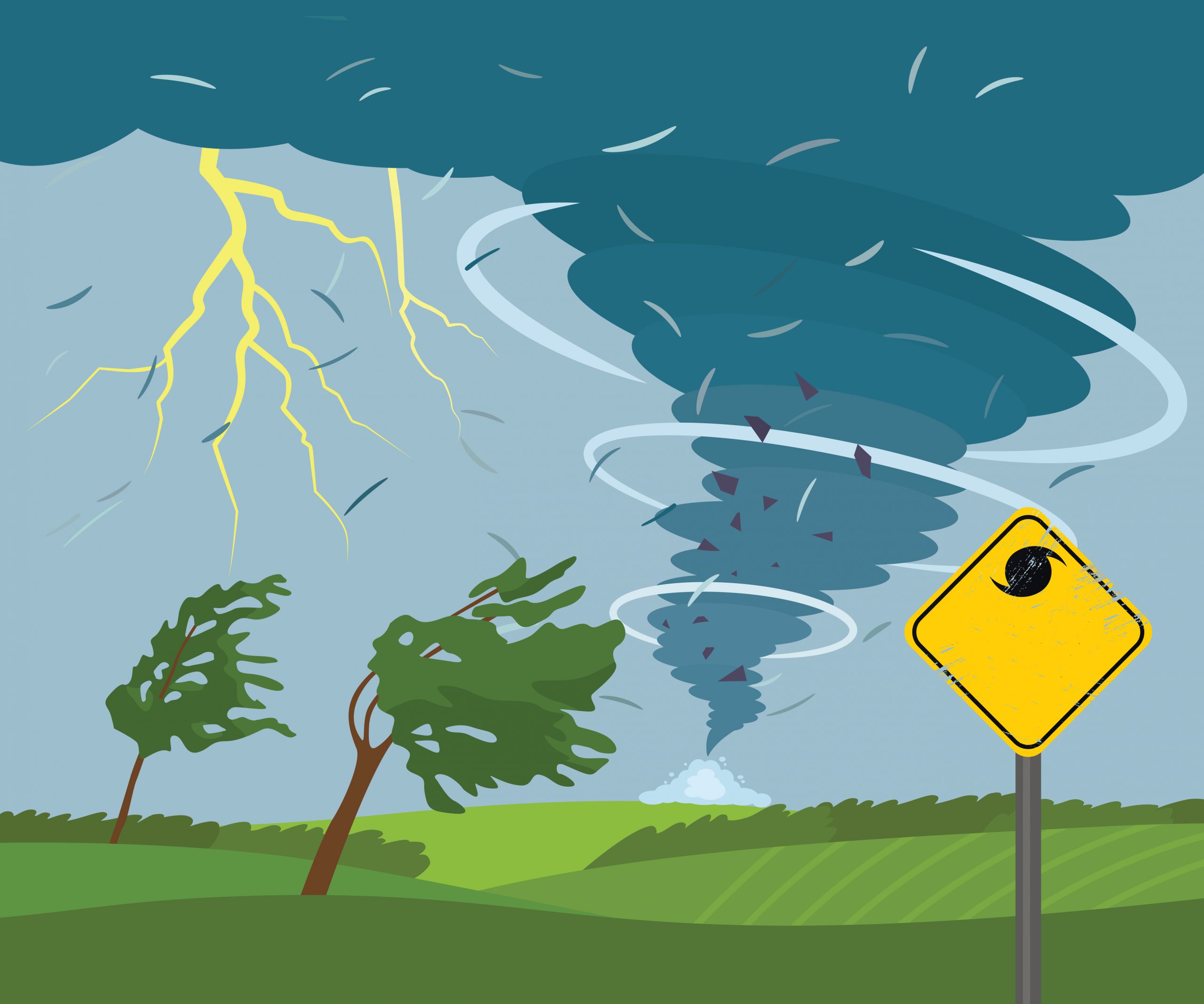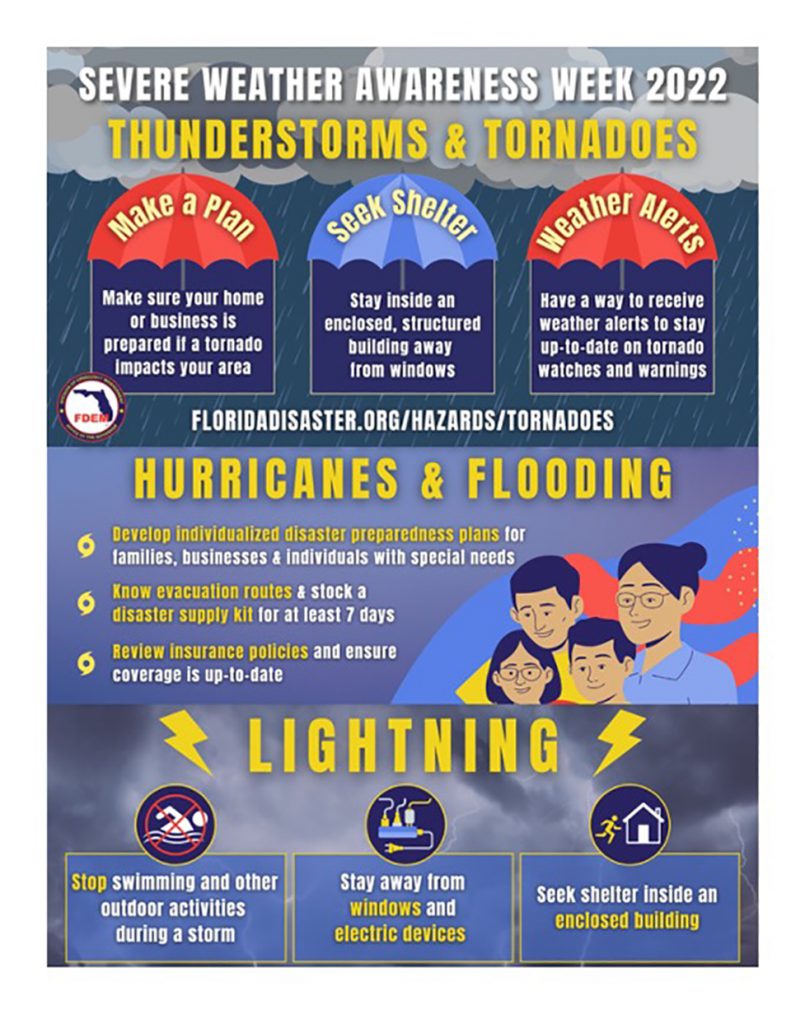
Severe Weather Week is a Reminder of the Importance of Year-Round Prep
While hurricane season is usually top of mind for most Floridians from June 1 through Nov. 30 of each year, severe weather can strike anytime, anywhere. In fact, two tornados recently damaged several neighboring counties, stressing the importance of being prepared for severe weather year-round, with or without warning. When storms develop, they can produce lightning, damaging winds, dangerous rip currents, flooding, tornadoes and wild fires.
To help remind people to review their emergency plans and be prepared for a variety of hazardous conditions, National Severe Weather Awareness Week takes place through the end of this week.
Severe Weather Facts: Did You Know…?

Florida is No. 3 among all states in the U.S. for the average number of tornadoes occurring each year.
🌩️ Florida is also the “Lightning Capital” of the U.S., with an average of 223 lightning events per square mile occurring in 2021.
🌊 In an average year, rip currents claim the lives of more Floridians than hurricanes, tornadoes, and lightning combined.
🌀 No other state has more hurricane landfalls than Florida and our unique location makes Florida especially prone to flooding.
🔥 Wildfires can happen year-round.
If You’re At Work When Severe Weather Threatens…
Sarasota Memorial’s color-coded guide for emergency responses — used to alert staff of potential disasters or threats arising in a facility — includes a “Code Brown” for severe weather or tornadoes.
If dangerous weather threatens while you’re at work, do you know how to respond? Here are some reminders for staff. (See also Policy#00.SAF.36).
How You’ll be Notified:
- For staff at SMH-Sarasota or SMH Venice: Once there is confirmation of a Tornado Warning (a tornado has been spotted in the area and could be headed in our direction) or a Severe Weather Alert, the hospital’s administrator on-call (or designee), and/or the Public Safety Shift/Watch Commander will instruct the hospital operator to announce a “Code Brown”, times three, via the overhead paging system. Operators will repeat the announcement after one minute.
- Ambulatory sites: Once there is confirmation of a Tornado Warning or a Severe Weather Alert and if there is not an overhead paging system, the phone tree will be used to alert departments within the building. If time permits, ambulatory staff will also notify the manager on-site or designee, and Property Management.
If There’s a Tornado or Severe Storm Warning:
If a tornado or unusually severe storm appears inevitable and there is a warning period, precautions should be taken, that include at a minimum, the following:
Patient Care Areas: The first priority is the safety of the patient:
- Draw all shades, drapes or other window coverings as protection against shattering glass and other flying debris.
- Lower all patient beds to the lowest position, and move the bed into the hallway or as far away from the windows as possible.
- Patients who cannot be moved to an interior location need to be protected with extra padding, i.e.; blankets, pillows, towels, etc.
- Close all doors to minimize wind/flying debris.
- Move/direct all ambulatory patients/ visitors to the closest safe shelter on the lowest floor possible. Seek protection in an interior room or hallway.
Non-Patient Care Areas
- Draw all shades, drapes, or other window coverings to protect against shattering glass or flying debris.
- Close all doors.
- Lock all exterior doors if time permits.
- Direct visitors/staff to the closest safe shelter on the lowest floor possible. Seek protection, such as in an interior room, hallway, or under a desk.
While there are often warnings before tornados occur, they sometimes can strike with no advance notice. If a tornado or bad storm appears inevitable and there is little to no warning period, staff are asked to do their best to protect themselves, patients and others from harm and injury.
After the tornado or severe weather passes (with confirmation from the State Weather System, an “All Clear” will be called, and staff can begin the recovery/restoration process.
Make sure to check with your supervisor or see your department-specific policy if you have questions. The full policy can be found on SMHCS Pulse Policy #00SAF36.
Sarasota Memorial Emergency Management Information:
Make sure to visit the Emergency Management Department page on PULSE for additional Preparedness items and to keep up on important information such as upcoming drills, disaster training & education, hurricane season information, decontamination and much more. If you’re on in the hospital network, CLICK HERE to access the site or look for the Emergency Management icon on the PULSE home page.
Family Preparedness:
Ever summer, staff join other Floridians in reviewing their hurricane preparation plans for their families and homes. Knowing that tornadoes and other severe storms can occur any time of the year, here are some safety reminders to help keep loved ones safe.
- Have a family emergency plan in place and practice it with all family members.
- Locate a safe room away from windows in the interior of your home.
- Have an emergency kit ready to go.
- Have a NOAA Weather Radio in your home.
- And remember when “Thunder Roars – Stay Indoors”
- Sign up for free emergency alerts from Alert Sarasota County; CLICK HERE.
- FEMA has a new text feature that allows community members to text “shelter” and their ZIP code to 43362 to get a list of nearby shelter locations within 200 miles of their ZIP code. The texting feature is available across all 50 states and U.S. territories. Shelters identified through the text feature are pulled from data managed by the American Red Cross. The public should also look for updates and information from county and state officials, as they may be able to point survivors to additional shelters and resources not included in the text feature.
- Sarasota County residents with qualifying medical needs are encouraged to apply for registration as a medically-dependent person (MDP). Qualified residents will be included the county’s registry for transportation and sheltering at a local medically dependent Evacuation Center during a disaster. CLICK HERE for information.

Other Helpful Websites:
- www.ready.gov
- https://www.weather.gov/nwr&ln_desc=NOAA+Weather+Radio/
- www.fema.gov
- https://www.floridadisaster.org/
- https://www.ready.gov/kids
- https://www.scgov.net/government/emergency-services/hurricane-preparedness
